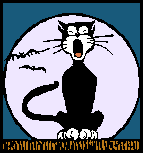
Thai TESOL Bulletin, 8(1), 32-39, 1995.
|
How to Use Cartoons in the EFL Classroom1 Johanna E. Katchen |
When we think of cartoons, we may be reminded of naughty children sitting in front of the television before dinner instead of starting on their homework. They may be watching an animated mouse committing unspeakable violence on an animated cat, both of whom completely recover by the next cartoon, or they may be mesmerized by futuristic creatures annihilating each other with yet-to-be invented weapons of destruction. These programs vie for children's attention most mornings and weekday afternoons. They are after-school entertainment, often violent, that generally has no place in the classroom.
Not all cartoons are violent, however, nor do they all run the
usual five minutes. There are cartoons 20-25 minutes in length made to fit
a half-hour time slot, such as the earlier Peanuts stories (for example, A
Charlie Brown Thanksgiving) or the popular animated situation comedy The
Simpsons (on STAR-plus). These may have worthwhile lessons to
teach. Some of the most popular full-length films, from Disney's Fantasia
to Snow White and the Seven Dwarfs to the more recent Beauty and
the Beast and The Lion King are animated. Classic fairy tales,
novels, even Shakespeare plays come in animated versions. Thus there is
quite a variety of relatively good material from which to choose.
Negative Features
Before we plan on using cartoons in our English classes, we would be wise to consider some of the specific language features which make them more difficult for nonnative speakers to understand before mentioning the positive features that make cartoons worth considering for ELT use.
No Clues from Visual Articulation. One way in which video helps in comprehension is that it often lets us see the speaker's mouth, from which we get clues as to what sounds or sequences of sounds the speaker is producing. These clues are completely absent in cartoons because we are not watching real people. The characters' mouths are made to move in imitation of real people, but the subtle movements of lips, tongue, and jaw that help us identify speech sounds even when we cannot hear them are completely missing.
The Use of Children's or Unusual Voices. Another feature of cartoons which makes them more difficult than other genres for nonnative speakers to understand is the use of children's or unusual voices. Often the main characters in cartoons are children, so naturally they are given children's voices (skillfully rendered by adults). Typical ELT listening materials for adult learners and even for young adult learners almost never include children's voices. This situation probably arises from the assumption that most adults indeed study English to be able to communicate with other adults, and communication with children is felt to be, and often is, incidental or of marginal importance. The result is that English learners, particularly in EFL situations, have little or no experience in listening to the higher frequencies of children's voices.
Other than children, animals and other imagined creatures also populate cartoons. What kinds of voices should they have? Generally, smaller animals are given higher, more child-like voices, whereas larger creatures are given lower, louder voices. Other features of intonation and voice quality are added to make characters sound big and dumb, big and scary, big and wise, small and helpless, and so on. Again the nonnative speaker has little experience with comprehending these unnatural-sounding voices, although more and more we are exposed to artificial-sounding, electronically-produced voices from elevators, computers, and other technological devices.
Exaggerated Speech Features. The speech of these cartoon creatures, including futuristic humans and robots, may be given particular features (e.g., lisping, stammering, hesitations) or geographical dialects to indicate something of the personality of the character. These paralinguistic features are based on stereotypes the native-speaking society has about the speech of certain types of people, and these characteristics are transferred to the animals. Native speakers recognize the stereotypes without even applying conscious thought: for example, a lisping male may indicate effeminate behavior, a slow Southern dialect may be used to indicate laziness and/or less than average intelligence, a New York City accent may be used to portray a con man or wise guy. Nonnative speakers will most likely not recognize the added message or may interpret it according to the norms of their own culture. The two cultures may not share the same interpretation of the paralinguistic features.
Thus the nonnative speaker has to deal with the strange-sounding voices of animated creatures and even of adult characters. For those cartoons in which the main characters are children and the world of children is portrayed, adults are outsiders and their voices are meant to sound unnatural. In the Peanuts cartoons, adults never speak in recognizable words; they are sounds emanating from an unseen source from the telephone or from the teacher or parent who is never seen on screen. In cartoons where adult characters have main roles (for example, The Simpsons), they may sound like slightly over-zealous adults (e.g., Homer Simpson's booming voice) or have voice qualities that some humans normally have but taken in cartoons to extremes (e.g., Marge Simpson's grating voice).
Positive Features
Appeal to the Child in Us. For most of us, children and adults alike, cartoons are appealing. We feel we are entering a dream, a fantasy world, and that we are escaping from everyday reality. Cartoons are colorful and amusing. They are pure pleasure. Although older folks may prefer Mickey Mouse or Cinderella over the more modern space war types younger people seem to like, they are still entertainment that we enjoy. Therefore, if we teachers want to use a cartoon or part of one as a stimulus for some language activity in the classroom, we already have the students' willing attention. Even with students whose native language is English, using animated versions of well-known stories can give the more unwilling students their first exposure to literary classics and perhaps even stimulate them to pick up the book.
 Story
Line. Cartoons usually tell a
simple story that is easy to follow. Often the good
character is pitted against the bad character of the forces of evil, and the
good always conquers the bad. Because of the length of the typical
cartoon, about 5 minutes, the story cannot get too complicated. Even the
20 - 25 minute cartoon story usually has a simple plot that can be exploited for
classroom use, particularly if it is broken down into scenes. The
full-length is too long to show at one sitting; our job is not to entertain
students but to give them opportunities to use and improve their English.
If we have a cartoon film we especially like, we can use our favorite scene or
two to spark some language activities in class, then let the students watch the
rest on their own time in the lab if they are interested. We could really
get their interest if we ended on a cliff-hanger, a point of suspense.
Story
Line. Cartoons usually tell a
simple story that is easy to follow. Often the good
character is pitted against the bad character of the forces of evil, and the
good always conquers the bad. Because of the length of the typical
cartoon, about 5 minutes, the story cannot get too complicated. Even the
20 - 25 minute cartoon story usually has a simple plot that can be exploited for
classroom use, particularly if it is broken down into scenes. The
full-length is too long to show at one sitting; our job is not to entertain
students but to give them opportunities to use and improve their English.
If we have a cartoon film we especially like, we can use our favorite scene or
two to spark some language activities in class, then let the students watch the
rest on their own time in the lab if they are interested. We could really
get their interest if we ended on a cliff-hanger, a point of suspense.
Language. Although some animated programs, such as full-length films and some TV programs like The Simpsons, are aimed also at an adult audience, most shorter cartoons, the kind shown on Saturday mornings and weekday afternoons, are aimed at children. The child or creature characters talk in a language the children understand. They use contractions, elisions, children's vocabulary, and slang terms. These features, in addition to the strange voices, add to the language learner's burden, but they also provide an excellent opportunity for exposure to slang, ordinary street terms, and children's language.
Culture. Many cartoons are particularly rich in cultural content. For example, we may see children considering whether to do something that their parents or teachers would not approve of; the children already know what is and is not permitted in their culture. Or we may see children interacting in school and compare whether they behave the same way as in our students' native culture. Better quality cartoons have a moral or teach a lesson, such as "cheating on a test is wrong" or "if you cheat you will not only be punished, but you will hurt others, too." Programs like The Simpsons, aimed at adults, deal with social and moral issues in a humorous yet thought-provoking way; in one episode Marge's successful crusade against cartoon violence also resulted in a ban on showing a famous nude statue at the local museum and brought her into conflict with the American First Amendment right of freedom of speech.
Choosing a Cartoon to Use in Class
Theme. The most obvious reason for using a cartoon in class is our desire to utilize its content to teach about a topic. Good cartoons tell a story and have a moral or lesson to teach. Longer cartoons such as The Simpsons often present topical issues such as TV violence versus censorship or the illegal reception of cable TV, so, like other genres, the video can be part of a set of materials on a topic. A pointless cartoon or the usual mouse-outsmarts-cat variety probably does not have enough intelligence to come to school.
Language. Despite silent viewing for prediction or dialogue activities, we usually use a video for its language to provide students with listening input. Some cartoons contain mostly action and have very little dialogue. Others contain too many strange voices combined with sound effects that further obscure clarity.
It is probably wise to choose the more simple, old-fashioned type of cartoon, the kind that portrays small children (or animals) talking with one another. Because the story is usually calmer (few, if any, fights or chases), the characters talk more slowly and without the quality of excited voice (the use of an unusually high pitch). It is also more likely that in this type of cartoon, the characters will be made to speak more like the way ordinary children do speak to one another. The Charlie Brown/Peanuts cartoons are very good examples of this more old-fashioned type. As an added benefit, these stories have very little violence an are so cute and innocent that they offend no one.
Activities2
Good teachers always spend some time introducing the topic of the lesson. Often our pre-teaching activities bear a relationship to our purpose for using the materials. For example, when we use a cartoon as part of a unit on a particular topic, such as the Halloween holiday, the cartoon may be only one of a series of materials illustrating various aspects of that topic.
Cloze. Because the language of cartoons is rather unnatural, students need some extra help in comprehending it. To help students get used to the voices, we can prepare a one-page cloze from the beginning of the cartoon, leaving out only single words or simple phrases, in affect giving students about 80% of the transcript. After they have had guided practice in listening to a few minutes of the cartoon in this way, they may become more used to the special characteristics of each character's voice. Upon completing and checking their cloze (a completed version shown on an overhead projector is useful), students can take the parts of the characters and imitate their intonation, voice quality, and expression, making as much noise and having as much fun as they like.
Reading a Transcript. If there is a story worth understanding, Particularly for longer cartoons, we may want to prepare a complete transcript for one or more scenes and have students take the roles before viewing. In this way students have a chance to read and comprehend what they are going to hear and they have a chance to speak out the lines themselves. The teacher can comment on vocabulary or idioms. Then students can watch without the text.
Performing a Mini-Play. If students have a complete transcript of a story, a cartoon or that of another genre such as a situation comedy, they can act it out in mini-play style. The advantage here is that they can mimic and learn the proper intonation and expression from the video. Our students have done this with A Charlie Brown Thanksgiving.
Comprehension Questions.
Comprehension questions can be given before viewing, with students
predicting the answers. To aid comprehension, questions can focus
students' attention on the main points of the story. In Yes, Virgina,
There is a Santa Claus (1974, Wolper Productions, 24 minutes), based on a
letter to the editor and reply that appeared in The New York Sun in 1897, a
little girl writes a letter to the newspaper to find out if there really is a
Santa Claus. Giving students the following questions before viewing may
focus their attention on the main points of the story.
| The children's teacher gives them an assignment. What do they have to do? |
| Do you believe in Santa Claus? Do the children? How do the other children treat Virginia? |
| Virginia asks four adults if there is a Santa Claus. What do each of them answer? |
| Who is Tommy? What does he suggest that Virginia do? |
| Who is Mr. Church? How does he feel about Tommy? |
| How do the other children feel about Virginia and her ideas at the end of the story? |
Because students know that such stories usually follow a pattern of conflict and resolution, they can predict that Virginia's classmates will disagree with her at first but accept her ideas in the end.
Related Reading. The cartoon Yes, Virginia There is a Santa Claus mentioned above is based on a famous newspaper article which is printed in most Christmas anthologies. It makes good background reading before showing the cartoon. Toward the end of the cartoon, the teacher reads most of that newspaper article aloud, so at this point our students will be familiar with it.
For cartoon versions of the classics, the original books are usually quite long and the cartoon version may take an hour or more, too. However, a cartoon version could be used as an introduction of lead-in to the reading of a literary piece. For example, the original Washington Irving The Legend of Sleepy Hollow is about thirty pages long and filled with hard words, many of which are now archaic. Yet it is a relatively simple story, a love triangle, and one of the men plays a trick on his rival, or was it a ghost? It both gives the flavour of early Dutch settlements in the Hudson River Valley (upstate New York, USA) a few hundred years ago and tells a great Halloween story that just about all American school children know. It would be shame for our students to miss out on it because of the vocabulary. Why not hear the story from a good cartoon?
 One particularly good version of the abovementioned story is
narrated by Glenn Close (1988, Rabbit Ears Productions Inc., 25 minutes).
Unlike the typical cartoon, here the narrator, who is a famous actress, modifies
her voice as she takes the roles of the various characters. The scenes are
presented as a set of still pictures that move only slightly, and the effect is
that of a good storyteller with a clear voice who illustrates the story with a
set of well-chosen pictures. Of course, we hope that the students will
eventually read the text in the original, and when they do, they will already
know the basic story.
One particularly good version of the abovementioned story is
narrated by Glenn Close (1988, Rabbit Ears Productions Inc., 25 minutes).
Unlike the typical cartoon, here the narrator, who is a famous actress, modifies
her voice as she takes the roles of the various characters. The scenes are
presented as a set of still pictures that move only slightly, and the effect is
that of a good storyteller with a clear voice who illustrates the story with a
set of well-chosen pictures. Of course, we hope that the students will
eventually read the text in the original, and when they do, they will already
know the basic story.
A high-quality, full-length film could be compared with the original fairy tale; or two versions of classics, one a cartoon, one a traditional film, could be compared with each other or with the text. Obviously, these activities require some special skills and could be a part of or an element added to a literature class or form part of a class on video interpretation of literature. In such cases, English should be used to discuss characterization, animation, and so on.
Teaching about Holidays. Cartoons with a holiday theme may be used to teach something about how that holiday is celebrated in that country or culture. In East Asia, stations such as STAR-plus show such cartoons around Christmas and also perhaps around Thanksgiving, Halloween, Easter. For related reading and background on American holidays, see Tiersky, E. & Tiersky, M. 1990. The USA: Customs and institutions. Third edition. New York: Regents Publishing Company, Inc.
The Charlie Brown/Peanuts set have addressed just about every American holiday. In Happy New Year, Charlie Brown! poor Charlie Brown has been given a big assignment over the Christmas and New Year holiday: read Tolstoy's War and Peace and write a book report on it. Most students can sympathize as they think of the homework assignments they were given over the holidays. Around his struggles, Charlie Brown's friends are planning a New Year's Eve party, making resolutions, planning whom to kiss when the clock strikes twelve midnight, and finally, of course, they all sing Auld Lang Syne--all the things Americans do for the New Year.
It is also possible to start with a holiday video and build a whole holiday unit around it, as we have done with A Charlie Brown Thanksgiving3 (1973, United Features Syndicate, 25 minutes). Using a reading from Tiersky and Tiersky (1990), students make up role plays about Miles Standish (referred to on the video), and we sing "Over the River and through the Woods" (sung at the end of the video). Students take the parts of the characters as we read through the transcript aloud before we finally watch and enjoy A Charlie Brown Thanksgiving.
Notes
1. Much of the material in this article was presented at the 15th Annual Thai TESOL Meeting, January 12 - 14, 1995, Bangkok.
2. Some of the material in this section first appeared in Katchen, J. E., 1994. Using cartoons to spice up holiday lessons. TESOL Video News, 4(5), 7, 9.
3. These activities first appeared in Katchen, J. E., 1993. Thanksgiving activities with A Charlie Brown Thanksgiving. Video Rising, 5(2), 7.